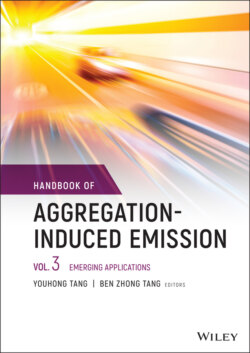Читать книгу Handbook of Aggregation-Induced Emission, Volume 3 - Группа авторов - Страница 23
1.3.3 Hybridized Local and Charge Transfer Materials Aggregation‐induced Emissive Emitters
ОглавлениеDifferent from Kasha’s rule, “hot exciton” process can happen between higher, excited triplet states to emissive singlet Tm → Sn (m ≥ 2), which was discovered in 1962 [123]. This process with 100% IQE in theory was often accompanied by HLCT excited state, where LE state decays fluorescently, while CT state upconverted from 3CT to 1CT and then to emissive 1LE state, as a result of close LE and CT states [28–31]. Ma et al. first reported several HLCT emitters of donor–acceptor (D–A) structures, and the related OLEDs’ excellent EL performance [28]. As the AIE characteristics also grafted into the HLCT materials, it enabled these emitters to have high efficiency in aggregated state, with spectrum from blue to green and red.
Our group utilized the most common AIE‐active group of TPE to combine with imidazole, and three blue novel emitters TPEI, TPEMeOPhI, and 3TPEI were prepared (Figure 1.8), showing both HLCT and AIE behaviors. Their nondoped OLEDs can be fabricated through facile process, with medium maximum EQE of 2.41, 2.16, and 3.13%, and slight efficiency roll‐off [124]. Tang et al. also took advantage of TPE moiety to prepare two green AIE‐active emitters TPE‐NB and TPE‐PNPB (Figure 1.8), both of which exhibited double slops of stokes shift versus different solvent parameters, suggesting the existence of both LE and CT state. The OLED based on the emitter of TPE‐PNPB showed better EL performance, with maximum EQE of up to 5.35% as a result of weaker D–A interaction [125]. With regard to the red HLCT‐AIE emitters, the TPE’s CN derivatives were usually applied as a high‐efficient luminescent building block, based on which Lu et al. prepared TPATCN (Figure 1.8) with another building of 2,3‐bis(4‐bromophenyl)fumaronitrile. The density functional theory (DFT) calculation showed larger energy gap between T2 and T1 and smaller energy splitting between T2 and S1, which prohibited the intersystem conversion and activated the “hot exciton” process. The nondoped OLED based on TPATCN exhibited strong NIR emission with maximum EQE and luminance of 2.58% and 7025 cd/m2, respectively [126]. The contribution of AIE property to the highly efficient HLCT mechanisms were further confirmed by Wang et al. through the QM/MM method [127]. Similarly, based on the same AIE‐active moiety, Yuan and Zhang et al. prepared AIE‐HLCT emitter of BDPACS (Figure 1.8). Its nondoped OLED could only reach the maximum EQE of 0.41%, as a result of exciplexes or excimers formed, while the doped OLED with BDPACS embedded into host of 2‐methyl‐9,10‐di(2‐naphthyl)anthracene (MADN) exhibited significantly enhanced maximum EQE of 6.8% [128]. Through substitution of the vinylene groups with CN groups at different positions, two isomers of α‐CN‐APV and β‐CN‐APV (Figure 1.8) were prepared by Ma et al., and the isomer with closer intermolecular stacking showed higher maximum EQE ( β‐CN‐APV : 5.3%) [129].
Figure 1.8 The structures of hybridized local and charge transfer materials aggregation‐induced emissive emitters.
